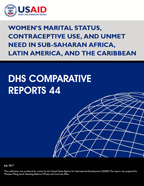- PUBLICATIONS
- JOURNAL ARTICLES
- ACCESS PUBLICATIONS
Publications Summary
- Document Type
- Comparative Reports
- Publication Topic(s)
- Family Planning, Household and Respondent Characteristics
- Language
- English
- Recommended Citation
- Wang, Wenjuan, Sarah Staveteig, Rebecca Winter, and Courtney Allen. 2017. Women’s Marital Status, Contraceptive Use, and Unmet Need in Sub-Saharan Africa, Latin America, and the Caribbean. DHS Comparative Reports No. 44. Rockville, Maryland, USA: ICF.
- Download Citation
- RIS format / Text format / Endnote format
- Publication Date
- July 2017
- Publication ID
- CR44
Download
 Women's Marital Status, Contraceptive Use, and Unmet Need in Sub-Saharan Africa, Latin America, and the Caribbean (PDF, 1090K)
Women's Marital Status, Contraceptive Use, and Unmet Need in Sub-Saharan Africa, Latin America, and the Caribbean (PDF, 1090K)
